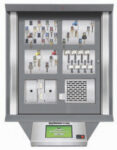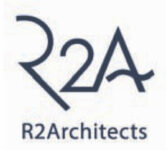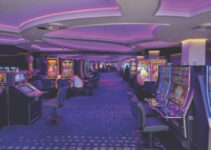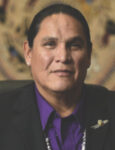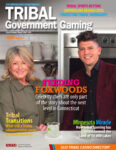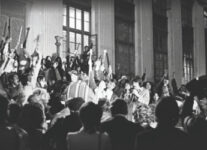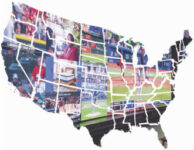
Casino
Tribal gaming is the perpetual Rubik’s Cube for the nation’s leading designers and architects.
Its varied look—entailing both subtle enhancements and overt design statements—mirrors the layered complexity of the world’s largest-selling toy. Designers figuratively turn the blocks, flip them, change colors and tinker endlessly to solve the financial puzzles of a multibillion-dollar industry.
More than 400 tribally owned facilities generate about one quarter of the nation’s gaming revenue, with operations ranging from small and intimate to monolithic powerhouse.
Tribal leadership is equally varied. Some operators make quick decisions. Others have large chains of command with conflicting views over property design message. Some tribes advertise their culture; others minimize it. Gaming houses look different on either coast and in the Native American heartland.
All of this must somehow blend into construction, on time and on budget, especially now. For the first time ever, Indian gaming revenues slid last year (slightly), meaning that tribes must increasingly blend heritage with sound gaming and hospitality principles.
So how do new trends in culture, finances, marketing and the customer base determine the design and direction of tribal government gaming?
It’s like asking the Pope about religion: Everyone has a different opinion.
Design flexibility is most essential because it enhances creativity and separates them from cheaper counterparts with cookie-cutter approaches.
Tribal properties will spend millions to make a statement, but the question is, “what statement,” and “where on the property will it go?”
The Heritage Home Run
Chief Boyd, a Native American and co-founder of Thalden Boyd Emery, says his company works with 87 tribes and 130 casinos, at last count. Gaming has twofold significance for Boyd, a principal of the company, based in Las Vegas, Tulsa and St. Louis. Many of its tribal projects are in Oklahoma.
As a Cherokee Nation member, Boyd is acutely aware of improving the lives of the tribal community. The 50-year architectural and design veteran has seen a rise in the living standards of Native Americans in the Oklahoma region. He proudly notes that advances in health care have just begun pushing the life expectancy of Indians beyond 59 years.
Boyd understands the need for tribal elders to make decisions, even if that means a deliberate process followed by an abrupt change. Oklahoma tribes often maintain more individuality than brand-driven counterparts on the East and West Coasts.
“Because cultural expression varies from tribe to tribe, what you generally end up with is a modern facility with a lot of heritage woven into it,” Boyd says. “You may, for instance, want to be sensitive about what type of carpet you will select, because that is going to be walked on. There are different feelings about that. We follow the lead of the tribe we are working with.”
A typical blend of these concepts may produce tribal expression in the ceiling and the floor and a gaming center focused on the action. Architects must also reconcile scores of opinions.
“When we worked on the original Potawatomi casino in Milwaukee, we were involved with 84 elders,” Boyd says. “A lot of what we designed came from them. In the center of this casino, one of the things they found exciting was the expression of the four seasons. Not only can it be culturally pleasing, but it can help the customer who wins find it easy to go back and find the machine he was on. He can line it up by what season the machine was in.
“The impact was huge. We were told that for a time it was the highest-drop casino in the world, getting $1,000 a day per slot.”
In this case, too many cooks did not spoil the broth. Architects must not only listen to their clients, but maximize natural geographic advantages. The Art Deco area of Tulsa, Oklahoma, enhanced by an oil boom, created factors that led to the formation of successful casinos, Boyd says. Many Cherokee casinos combine tribal culture with Las Vegas excitement.
They also embraced innovation. The Building Information Model (BIM) has become a significant part of the presentation process for big projects over the past seven years. It replaced hand drafting with electronic models, an effective tool for tribes which often change their design plans.
The BIM allows clients to visualize their expected changes quickly and even walk through a 3D model. This is an important benefit, allowing tribal executive members, staff, architects and a slew of structural, mechanical, electrical and plumbing engineers to get on the same page. It enables everyone to witness the impact of changes before they occur and therefore make quick, uniform decisions.
Corporate Sophistication
Tribal culture occasionally forges its own branding. Memphis-based Hnedak-Bobo Group works on scores of tribal gaming projects. It garnered the 2007 Best Casino Design under $200 million, as recognized by G2E’s Casino Design Awards, for Riverwind Casino in Norman, Oklahoma.
More recently, Hnedak Bobo showed its diversity in creating two variations upon a client’s theme, via the Four Winds in Hartford, Connecticut, and New Buffalo, Michigan.
The New Buffalo property opened in April 2011 and Hartford is under construction.
“The Four Winds Hartford Casino design is a multi-phased master plan with a first-phase 500-slot casino constructed on a 15-acre site,” principal Dike Bacon explains. “This first-phase design and construction was successfully completed on schedule (14 months from design start to construction end) and was completed on budget (52,000 square feet and $40 million all in).”
Bacon says the design intent of the new facility was to expand the brand of the tribe’s New Buffalo model. The design basis for the new facility in Hartford was to maintain a similar palette of materials, characteristic of Four Winds New Buffalo, without creating an exact copy of that first facility.
“We used materials such as stone, copper and red cedar to detail the exterior façade of the gaming facility,” Bacon explains. “A 50-foot-tall stone chimney sits adjacent to the three-lane porte cochere, acting as a landmark for casino guests. The tall icon feature helps to promote the Four Winds brand, as well as signify the tribe’s cultural identity as the ‘keepers of the fire.’ Other details such as the round red cedar log columns at the porte cochere and the standing seam metal mansard roofs on the east façade were designed to help link the property to the first Four Winds Casino in New Buffalo.”
This was one case where the tribe openly celebrates its heritage via the design. That gave Hnedak Bobo free rein to maximize the tribe’s identity.
“The interior design incorporates a range of significant tribal motifs and symbolism—from N/S/E/W elements informing the directional placement of building elements, to important animals such as the river otter and bear that are integrated into highly visible custom-designed light fixtures and fireplace elements,” he says. “Within the chimney tower, located between the entry foyer and the retail shop, is an ‘eternal flame’ hearth room for guest lounging, featuring a 360-degree circular fire pit covered by a copper hood, holding further symbolism of the tribe’s cultural heritage. The tribe was the first to use copper metal in tool and jewelry making.”
A Grand Design
Tom Hoskens viewed the evolution of tribal pride into corporate muscle. His Minnesota-based Cuningham Group jumped out of the box by servicing seven Grand Casino properties at the advent of Indian gaming in the late 1980s. The incorporation of partners like Hard Rock at the Pueblo Isleta in Albuquerque, New Mexico and Harrah’s in Cherokee, North Carolina, propelled several of his projects to prominence.
Harrah’s Cherokee, nestled at the foot of the Great Smoky Mountains, provides an excellent example. The Cuningham Group has already been awarded a prestigious HOSPY (given by the Network of Executive Women in Hospitality) award, for its work on a $630 million-plus expansion scheduled for completion in the summer. Cuningham won it for Suite Design and Hotel and for having the best hotel lobby in the country.
“We have a philosophy of the metaphor in that each building should tell a story,” he says. “For the Cherokee property, the original metaphor was in the fact that this is a mountain lodge, perfectly placed in the Great Smoky Mountains. It is a wonderful site right alongside a mountain stream with trout fishing. This modern lodge reflects the Great Smoky Mountains and even has soft curves on all the rooftops.
“We modeled the casino after the curving lines of the Great Smoky Mountains. The tribes grew up in the mountains. They have assimilated nature into what they do; it is a part of them. The casino has four major parts. You have Mountain Breeze, Woodland Moon, Rivers and Valley and Earth Water. Each has a zone, each has different colors and each is separate visually from the other.”
The Harrah’s branding enables financial muscle and flexibility for the designer or architect. High-end name restaurants, convention centers and additional hotel rooms all fall under this category. Hoskens says the grand finale of the five-year expansion will be a magnificent rotunda, with eight large trees within it, waterfalls, an extraordinary light show and a number of other technological components. And what about 10-15 years hence?
The tweaking, years down the road, could entail changing the way the water looks coming down the glass, he says, or the operators may want to add a bar area. Carpets change all the time. But the exterior of the building would not.
Hoskens notes that tribal properties, just like non-Native American interests, are expanding into resorts.
Flexibility Meets The Future
Bergman, Walls and Associates, based in Los Angeles, Las Vegas and Ho-Chi-Minh City, has operated for 18 years and employs 50 people. Its Snoqualmie (Wash-ington) tribal gaming project garnered an Annual Excellence Award from the Wall and Ceiling Bureau in 2009.
While noting the diverse nature of tribal gaming preferences, the company has seen some subtle, relatively recent shifts.
Top executives Joel Bergman and Brad Schulz, who account for nearly 50 years experience, say those tribes are upgrading their dining areas, seeking more live entertainment venues and trying to position themselves against increasing competition. The architecture and design provide the environment for them to pursue and maintain market share. In a constantly changing industry, tribes need game plans both for now and in another decade.
“If a property goes 10 years without being modified, you’re doing pretty well,” according to Schulz, who was elevated to a fellow by the American Institute of Architects in 2010. “Properties have to reinvent themselves anyway, more than just with a new coat of paint. If you have been the only property in town, you know that people would jump over a couple hoops to come to your property. Now, with so much competition, you may want to guard against the casino five miles away being the kinder, gentler property, so to speak.
“So we design for flexibility, allowing things that can change easily. You won’t be limited, for example, by structural elements that can’t be moved. The buildings are open.”
Both architects see a slow transformation of the prototypical gaming facility over the next few years. Fewer machines. More electronically driven action via devices like iPads, utilized by players at the pool or another remote portion of the property.
“Tribes are going to start asking for more lounges to be placed throughout their facilities,” says Bergman, who garnered a Sarno Lifetime Achievement Award for casino design in 2006 at G2E. “They will want to have them placed throughout the facility, helping to attract a younger crowd. We are going to be seeing more gaming lounges. That will attract a younger crowd at night and on weekends, but at the same time the tribes will have to be able to do that without alienating a good segment of their older customer base.
“There will always be a segment of the population that wants to sit at the sports book and scream for their bets alongside other people, but we are heading for a time when the last of the traditional ‘action’ will be at the pit. As younger players come in and are more adept at the iPad and iPhone, this will cause a change in the makeup of the properties.”
Seminole Agenda
Ken Kulas, principal for Las Vegas-based Cleo Design, witnessed his own version of tribal gaming evolution. Along with Ann Fleming, he runs an 11-year-old company that grew in step with the Seminole Tribe. Cleo Design helped build the original Hard Rock casinos in Tampa and Hollywood, Florida, followed with several renovations, and now designs a Tampa expansion entailing restaurants, bars and larger gaming space.
The parties have learned together.
“Our first encounters were very surprising in that ‘tribal’ design influences were not requested,” Kulas says. “With the exception of ownership branding, the design directive was to be more ‘Las Vegas’ in influence first. As projects progressed, we typically found ourselves adding more subtle tribal signatures or retail venues that consolidate education of the heritage.”
Cleo Design has been named in Interior Design magazine’s Top 200 for the last six years. Kulas says some things don’t change regardless of the client. Every property needs an arrival statement, for instance, and large open spaces require an over-the-top feature to set the facility’s design tone. Kulas considers the large space a great opportunity to use iconic forms or imagery, whether abstracted or literally interpreted.
While tribal properties face similar challenges to non-tribal facilities, they offer one intangible.
“Even though the cash-flow support may come from within rather than traditional banking entities, committees and current revenues (pending the current success of the gaming floor), all are deciding factors to the level and speed of the design and construction,” Kulas says. “Indian gaming, however, sometimes has the advantage of being located in a unique geographical area that has less competition. There may be a less of a risk factor in the development of gaming institutions with remote locations being ‘the only game in town.’”
Seeing The Contrast
SOSH Architects, based in Atlantic City and New York, has worked in several Native American hospitality projects in the Northeast, Southwest and Northwest. Its clients-served list reads like a who’s-who in Indian Country: the Mohegan Tribe and the Mashantucket Pequot Tribal Nation in Connecticut; the Seneca Nation of Indians in Buffalo and Niagara Falls; the Seminole Nation of Indians in Florida; the Cabazon Band of Mission Indians and the 29 Palms Band of Mission Indians, both in Palm Springs; the Cachil Dehe Band of Wintun Indians in Sacramento; the Gila River Indian Community in Phoenix.
Partner Tom O’Connor sees many examples of the three major tribal design philosophies.
“Any differences that exist between tribal and non-tribal design are as much related to the story that is being told by the project as they are tied into the differences between corporate and tribal owners,” he says.
“Clients usually want a design to express specific goals that relate either to brand, culture, customer or locale; and often it’s a combination of these factors. We also see tribes play against type, by requesting their cultural history not be the defining element.
“Finally, there has been such an integration of non-tribal executives into tribal gaming positions that the lines have been further blurred between tribal and non-tribal gaming design goals.”
Ongoing or recently completed projects for SOSH include Revel in Atlantic City, premiering in May 2012; several projects for the Seminole Hard Rock Casinos; the Town Center at Fantasy Spring Golf Resort; and Spotlight 29 Casino Resort Expansion in California. The success of the Spotlight 29 Casino and the collaboration that resulted in the property’s stunning design produced a Sarno Awards first prize for casino design in 2007.



